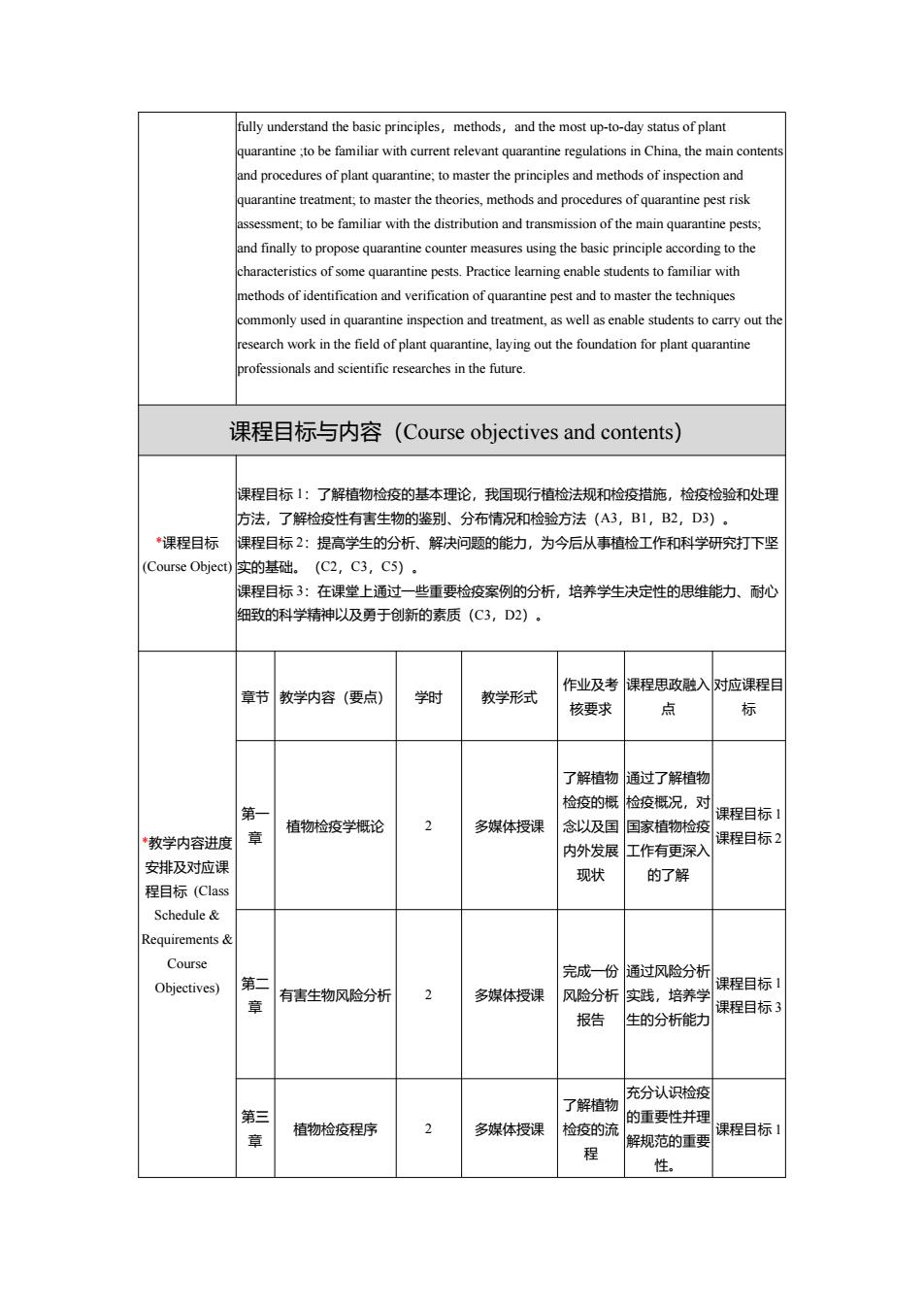正在加载图片...

fully understand the basic the mst up-toay and procedures of plantqurni to master the principles and methods of inspection and quarantine treatment to master the theories methods and proceduresofquranine pest risk assessment:to be familiar with the distribution and transmission of the main quarantine pests and finally to propose quarantine measures using the basic to the aamtcepetPactioelcamngeabehdcasofnlarwih commony used in quarantine inspection and reatment,as well asenable studentstocarryou th research work in the field of plant quarantne,layingout the foundation for plant quarantine professionals and scientific researches in the future. 课程目标与内容(Course objectives and contents) 课程目标1上:了解植物检疫的基本理论,我国现行植检法规和检疫措施,检疫检验和处理 方法,了解检疫性有害生物的鉴别、分布情况和检验方法(A3,B1,B2,D3), “课程目标课程目标2:提高学生的分析、解决问题的能力,为今后从事植检工作和科学研究打下坚 (Course Object))实的是础。(C2,C3,C5).。 课程日标3:在课堂上通过一些重要检疫案例的分析,培养学生决定性的思维能力、耐心 细致的科学精神以及勇于创亲的素质(C3,D2). 学时 教学形式 作业及 课程思政融 对应课程目 章节教学内容(要点) 核要求 点 标 了解特物通过了解特物 检森的概检疫据况.对 程目标 植物检学概论 多媒体授课 念以及国国家植物检 教学内容进度 课程目标 安排及对应课 内外发 工作有更房 现状 的了料 程目标Cas Schedule& Requirements Course Objectives) 第 份 通过风险分析 有害生物风险分析 2 多媒体授课 风险分析实践,培养 课程目标 课程目标 报告 生的分析能动 了解植物 充分认识检疫 植物检疫程序 2 多媒体授课 的重要性并 检疫的: 课程目标 群机范的重 性。fully understand the basic principles,methods,and the most up-to-day status of plant quarantine ;to be familiar with current relevant quarantine regulations in China, the main contents and procedures of plant quarantine; to master the principles and methods of inspection and quarantine treatment; to master the theories, methods and procedures of quarantine pest risk assessment; to be familiar with the distribution and transmission of the main quarantine pests; and finally to propose quarantine counter measures using the basic principle according to the characteristics of some quarantine pests. Practice learning enable students to familiar with methods of identification and verification of quarantine pest and to master the techniques commonly used in quarantine inspection and treatment, as well as enable students to carry out the research work in the field of plant quarantine, laying out the foundation for plant quarantine professionals and scientific researches in the future. 课程目标与内容(Course objectives and contents) *课程目标 (Course Object) 课程目标 1:了解植物检疫的基本理论,我国现行植检法规和检疫措施,检疫检验和处理 方法,了解检疫性有害生物的鉴别、分布情况和检验方法(A3,B1,B2,D3)。 课程目标 2:提高学生的分析、解决问题的能力,为今后从事植检工作和科学研究打下坚 实的基础。(C2,C3,C5)。 课程目标 3:在课堂上通过一些重要检疫案例的分析,培养学生决定性的思维能力、耐心 细致的科学精神以及勇于创新的素质(C3,D2)。 *教学内容进度 安排及对应课 程目标 (Class Schedule & Requirements & Course Objectives) 章节 教学内容(要点) 学时 教学形式 作业及考 核要求 课程思政融入 点 对应课程目 标 第一 章 植物检疫学概论 2 多媒体授课 了解植物 检疫的概 念以及国 内外发展 现状 通过了解植物 检疫概况,对 国家植物检疫 工作有更深入 的了解 课程目标 1 课程目标 2 第二 章 有害生物风险分析 2 多媒体授课 完成一份 风险分析 报告 通过风险分析 实践,培养学 生的分析能力 课程目标 1 课程目标 3 第三 章 植物检疫程序 2 多媒体授课 了解植物 检疫的流 程 充分认识检疫 的重要性并理 解规范的重要 性。 课程目标 1